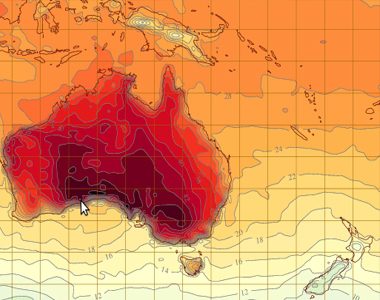It has been a very hot start of the year for Australians, with the first six days of 2013 all named among the hottest 20 days on record.
Yesterday marked the hottest day in the nation’s history, with the average temperature across the country reaching a sweltering 40.33. It surpassed the previous record, which had stood since 1972, by 0.16 of a degree. Entire states were placed on catastrophic fire alert as gusty winds and record termpatures fuelled over 140 bushfires in New South Wales alone.
In fact, the Bureau of Meteorology has even added two new colours to its climate monitoring chart to reflect the deadly new weather patterns; deep purple and pink now sees the range extending to push the 50 degrees mark, shades that are currently being used to predict forthcoming temperatures in some areas of South Australia in the coming days.
“The scale has just been increased today and I would anticipate it is because the forecast coming from the bureau’s model is showing temperatures in excess of 50 degrees,” David Jones, the head of the bureau’s climate monitoring unit told The Age.
But the 40-plus days aren’t about to end, with deep purple being used to forecast Sunday and Monday’s predicted 50 degree plus temperatures.
‘‘Clearly, the climate system is responding to the background warming trend,” commented Jones. “Everything that happens in the climate system now is taking place on a planet which is a degree hotter than it used to be.’’
‘‘We know that global climate doesn’t respond monotonically – it does go up and down with natural variation. That’s why some years are hotter than others because of a range of factors. But we’re getting many more hot records than we’re getting cold records. That’s not an issue that is explained away by natural variation.’’
Based on both regional and local weather patterns, including El Nino and La Nina climate cycles, as well as the Indian Ocean dipole, the Australian climate sees a complex web of factors come into play, all of which are directly linked to greenhouse gas-driven global warming.
Globally, 2013 will make it 27 years since the world experienced a month that was comparatively colder than average, signifying a gradually warming planet.







